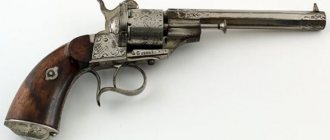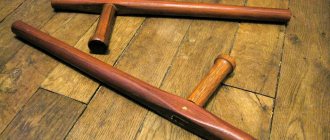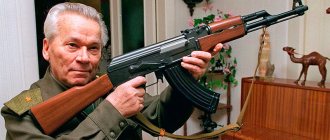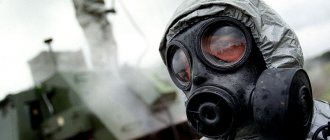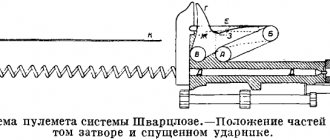A mace is a type of short-shafted bladed weapon with shock-crushing action, consisting of a wooden or metal handle (rod) and a spherical pommel (head), which can be smooth or studded with spikes.
The mace is one of the oldest types of bladed weapons, a direct descendant of the club, which man began to use back in the Stone Age. It became widespread in the late Middle Ages, which was due to the qualities of this weapon. The mace was great for breaking through heavy armor.
It is believed that the mace (as well as the club) was the weapon of choice for European warriors from various religious orders. The reason was simple: with a mace it was possible to hit the enemy without shedding his blood, that is, without inflicting open wounds.
An amazing metamorphosis occurred with the attitude towards this weapon. If during Antiquity it was treated as a despicable weapon of barbarians, then starting around the 17th century, the mace became a recognized symbol of the power and high position of a military leader. Maces were worn by Ukrainian and Polish hetmans, Turkish pashas, and in the 20th century it became the insignia of Polish Marshals and a symbol of the power of the President of Ukraine.
The mace, like most other types of bladed weapons, is widely represented in the legends and myths of different peoples of the world. Among the Celts, it symbolized Dagda, one of the main deities of the Celtic pantheon, the lord of life and death. In Christianity, the mace represented the betrayal of Christ and Judas. The mace was an attribute of the Greek hero Hercules and the muse Melpomene. In the Semitic tradition, the mace is a symbol of the deities Baal and Ninurta. Often the mace represents the phallus and male sexual power.
History of the development of the mace
The mace consisted of two parts: a wooden handle and a metal pommel. The main striking part of the instrument was its steel part. This edged weapon belongs to the category of impact-crushing action. It is not known for certain who invented and put the mace into use.
But it should be noted that the most ancient specimens found by archaeologists were from the Middle East, North Africa and southern Europe. The artifacts retained only the shock part; the handles rotted from time to time. The pommels come in various shapes: round, oval and lenticular.
In ancient times they were made of stone, and the specimens found prove that their ancestors achieved great success in weapons making. High-quality polished products had drilled holes. Such technologies were characteristic of the Neolithic era. And this is practically 9-4 millennia BC.
There are also finds from the Bronze Age. Various peoples inhabiting those territories made products very similar to a mace.
They were of various sizes and shapes. At this time, the materials used were copper, bronze and iron.
The methods of metal melting studied by artisans opened up creative spaces for experimentation. The handles themselves were also cast from metal. Sometimes, to improve the strength of the shaft, steel rings were used at the junction with the pommel.
Nails were driven into the eye of the striking part into the handle, after which they were welded and riveted. In some products, the pommel was driven into the handle shaft and a sleeve was welded on the outside. With the improvement of armor, craftsmen had to come up with new improvements to the mace.
In the Middle Ages, the iron mace was made with various sharp spikes on the surface of the pommel. Which could penetrate the strongest armor and shields. Such weapons were used until the First World War. Today this item can be found as a ceremonial symbol of power.
Ancient stone mace heads.
Family tree of modifications
The mace is a uniquely effective weapon with a long history. It has been used by warriors on all five continents at all times. Blacksmiths, in search of a better combat effect, modernized the mace into various subspecies and new types of completely new weapons.
Morgenstern (German: morning star) is a mace with a spiked top resembling the rays of stars. The striking part came in a variety of shapes, but the spikes were the hallmark of the weapon with a poetic name.
According to some evidence, morningsterns were in service before the First World War.
A beam is a mace with a cubic head with cut corners, sometimes there were spikes in the planes. It was widespread from the 11th to the 17th centuries in Rus', in the eastern Mediterranean, Eastern Europe, and in the Southeast among nomads.
Buzdygan (buzdugan, bozdukhan, buzdurkhan) is a type of mace, the top of which was made of stone covered with iron plates with small spikes; a buzdygan could be called an ordinary mace. It served as a training model for the peoples of the Carpathian region.
Shestoper and pernach are a multi-blade type of mace. The blades are located along the meridian of the top, i.e. parallel to the handle, sometimes twisted spiral. Initially, the blades were cut out of metal, but in X–XII they began to be welded, and after that the mace had two subtypes - pernach and shestoper.
Flail - the striking part is a weight on a chain or other flexible material that connects the apple to the handle. Instead of a chain there could be a strong rope, cord or belt. Used by infantry and cavalry from the 12th to the 17th centuries. According to the generally accepted classification, it is called a shock flexible-joint subtype of impact-crushing weapon.
Types of mace
Very diverse forms of mace heads are known. In addition to the usual spherical ones, there are biconical, polygonal, barrel-shaped and vertically flattened tips.
There were also pommels in the form of several spikes.
The warheads of some Mongol maces had a spike on one side. This made the product look very similar to a war hammer. The shape of the head greatly depended on the place and time of its manufacture. Classifying clubs is not an easy task.
Some historians include another close brother among them - the club. It is also an impact weapon, much like a mace. But still, they can be divided into two large groups:
- Simple. Solid products made of metal or wood. This also includes clubs.
- Composite. More labor-intensive to manufacture, they were distinguished by different materials for the handle and head.
The second group became widespread with the advent of heavy armor. Their further development led to the emergence of several smaller varieties; let’s look at them in more detail:
- primary The pommel consisted of several triangular or wedge-shaped metal plates. They were located parallel to the handle. This form was much better suited for breaking through armor. The entire force of the impact was concentrated on a much smaller area;
- shestoper. This is a type of pernach, which got its name due to the number of plates used in the design. There were six of them. The product gained the greatest popularity in Muscovy, Lithuania, Poland, Hungary and Ukraine;
- multi-plate mace. Such weapons were known back in the Stone Age, but they gained wide popularity in the Middle Ages. This type of weapon had a large number of blades, they were of very different shapes;
- buzdykhan This variety is very similar to the shestoper, but additional protrusions or spikes were added to the plates. The Ottoman Empire was the pioneer of such weapons, but then they appeared in Europe. It gained wide popularity in Transnistria, Bukovina and the Carpathian region;
- morning star. The name rather refers to the head of the product itself. It was elongated with sharp spikes. Such a pommel could be used as a movable part of a mace. It was connected to a handle, a chain or a belt;
- movable structure. The weapon is classified as a mace, but to this day disputes continue over the classification of the product and its origin. Such a mace consisted of a handle and a weight attached with a belt or chain. But it happens that some historians place such a mace in a separate group of the combat flail and flail;
- ceremonial mace. Over time, after the mace lost its military significance, it turned into a symbol of state and military power. This product was decorated with gold and precious stones. Italian and German masters have succeeded well in this matter. The mace was used as a ceremonial product in Turkey, Russia, Poland and Ukraine.
Examples of ceremonial maces.
[edit] Historical excursion
The harsh Russian military is sawing the mace.
The development of the Bulava began in 1998 as an alternative to the same high-quality product of the gloomy perestroika genius, the solid-fuel rocket R-39UTTH (“Bark”), which by that time had already fallen from heaven to mortal earth three times. As a result of the butthurt that formed among the senior management and a significant lack of money (at the current rate of financing the project was estimated at 20 (!) years), the development of “Bark”, already 73% completed by that time, was stopped and the baton was given to the Moscow Institute of Thermal Engineering, which , unlike KB im. Makeev, who developed the Bark, did not know how to make naval missiles, but he really wanted to. The main idea was to do it CHEAP, and specifically - to significantly reduce the dimensions, weight and throw weight, saw off all the whistles and fakes (for example, a system for passing through ice was planned for the Bark) and unify most of the parts of the ground-based Topol-M " and marine "Bulava" for greater savings and ease of production. The idea, beautiful on paper, turned into a total mess in practice: the number of standardized parts is decreasing and decreasing, money is being invested and invested, but the rocket still doesn’t fly. But that was later, and first the 27th Research Institute of the Ministry of Defense of the Russian Federation, which traditionally provided scientific and technical support for the development and testing of sea-based strategic missile systems, was disbanded, and Roscosmos research institutes (TsNIIMash, Research Institute of Thermal Processes, Research Institute of Mechanical Engineering Technology, Central Research Institute of Materials Science), and everything is wrapped up...
| ◄ ► |
A strange phenomenon in Norway on December 9 - the third stage of the Bulava burns out. It’s in the news
- For the first time, on May 24, 2004,
at the Votkinsk Machine-Building Plant, an engine kicked in during testing. Bene's note: only the engine was tested there, and for them such things during testing are a mandatory program. - September 23, 2004
is a black day for opponents of the project, because it did take off from the TK-208 Dmitry Donskoy nuclear submarine, based at the Sevmashpredpriyatie in Severodvinsk. From an underwater position. True, not so much the rocket itself, but its weight and size mock-up, but at least. - September 27, 2005
- another successful launch. Successful. From the White Sea with the nuclear submarine "Dmitry Donskoy" from the surface at the Kura training ground in Kamchatka. - December 21, 2005
- took off again, again successfully. - September 7, 2006
- and here it began to attack. Somewhere, someone went on a drinking binge, something was stolen, and the rocket, after flying for several minutes after launch, deviated from its course and fell into the sea. - October 25, 2006
- even more was stolen, and after several minutes of flight, the Bulava deviated from its course and flew to splash in the White Sea. - December 24, 2006
- the remaining bolts were removed from the rocket, the last tractor was stolen from the factory. The third stage engine failed and the Bulava self-destructed. - June 28, 2007
- found the screws, got the mechanics drunk, bought a new tractor. The launch was almost successful; the third warhead did not hit the target. - September 18, 2008
- launch - normally, flight - normally, separation of warheads - sucks. The rocket passed through the active part of its trajectory without failures, hit the target area, the warhead separated normally, but the stage for disengaging the warheads was unable to ensure their separation. - November 28, 2008
- SUDDENLY completely successful launch. - December 23, 2008
- after testing the first and second stages, the rocket entered an abnormal mode of operation, deviated from the designed trajectory and self-destructed, exploding in the air. - July 15, 2009
- “Bulava” self-destructed in the 20th second of flight. - October 27, 2009
- the rocket was unable to crawl out of the silo due to the activation of automatic protection. - December 9, 2009
- the third stage of the rocket failed. It turned out beautiful. - October 7, 2010
- a completely successful launch is reported. But you and I know. - October 29, 2010
- and again successful. The trend, however. - June 28, 2011
- plundered, unfortunately not everyone was able to do it, so the launch was successful. By the way, for the first time from a standard media - pl. type "Borey". WAIT. OH SHI~~ - August 27, 2011
- the second launch from the nuclear submarine Yuri Dolgoruky was successful. This time starting from an underwater position and at maximum range. - October 28, 2011
- third launch from the nuclear submarine Yuri Dolgoruky. Successful again. The missile warheads arrived at the designated location at the Kura training ground at the appointed time. - December 23, 2011
- the fourth, this time salvo (2 missiles) launch from the Yura. Another wine: the warhead of one of the missiles arrived in Kamchatka exactly on schedule. One - because during salvo launches only one or two missiles complete the full route; the rest, for the sake of economy, are not even equipped with warheads and are detonated immediately after the completion of the active phase. - September 6, 2013
- this time the rocket was launched from Alexander Nevsky. The spirits of stability and Putinism did not help this time; during the flight, the rocket apparently remembered the fate of the Proton-M that had fallen somewhat earlier. Fail, Shoigu will force him to shoot the unfortunate missile five more times.
| It should be noted here that, for example, of the first 10 launches of the most reliable Soviet missile R-36, 7 were unsuccessful, so for the new complex this is, in general, normal. And one should compare the racially faithful Soviet Sineva (R-29) with Trident, because these children of the Cold War were developed at a time when the teams were an order of magnitude larger, and funding did not lag behind them |
Total: 21 (22) full-fledged launches, of which 13 (14, counting the salvo as two) were successful (and the penultimate ones, until September 6, 2013 - 6 (7) in a row). Those who wish can compare it with the trials of the main opponent of our native prodigy. After a series of wins, fail in 2013 again resets the program to where it started.
- September 10, 2014
- successful start. They launched from the third boat of the series, Vladimir Monomakh, which was formally undergoing testing. The start also had the goal of trolling the Pindos against the backdrop of Ukrainian events. - October 30, 2014
- successful start. Launched from the nuclear submarine Yuri Dolgoruky. The missile warheads arrived at the designated location at the Kura training ground at the appointed time. A trend has become noticeable - launches from the Yura tend to be successful. - November 16, 2015
- and again a salvo launch from the Vladimir Monomakh. Again, a complete ass - one missile self-destructed, the second reached the Kura test site, but did not hit the target.
General description of the mace
The first stone maces had a simple design. A hole was drilled in the stone and a handle was inserted there. Nations that succeeded in stone processing carved figured finials. They cut out rounded tenons and lobes similar to modern gears.
On the territory of modern Russia, the mace was made from hardwood. Some sources indicate that the pommels were made from wood growths, which are a highly durable material. By the 11th century, the mace gained popularity in Russian lands.
In some cases, the head was made of two hemispheres cast from metal. The empty space was filled with stones or iron balls. This way they saved material for manufacturing. This mace had increased power due to the filler.
How much did the mace weigh?
The weight of the mace head itself ranges from 200 to 800 grams. And it was the size of a large tangerine.
What was the length of the mace?
The length of the weapon was 50-60 cm.
Among the Aztec and Indian peoples, the head was made in the form of animal heads. Massive maces made of alloys of copper and bronze were also popular with them. The striking part of which looked like a mushroom cap.
The wooden handle was used for quite a long time, until the 13-14th centuries. It was wrapped in leather or wicker material. At this time, armor was improved and improved.
It took a lot of force to break through them. The mace began to be made more massive.
The impact part began to reach 15 cm in diameter and weigh almost 3 kg. The wooden handle was no longer suitable, they began to make them metal. No tree can withstand such strong blows with such a pommel. Even two-handed maces appeared.
Their size reached 180 cm, and the head of such a weapon was made with an additional spike. This device was more like a pike that could be used to stab an enemy.
Modern replicas of ancient weapons.
Blacksteel of Yorrhast
Another two-handed mace associated with minion skills is Yorrhast's Blacksteel.
Automatically creates a Living Weapon when killed, and creates two minions at once, so when clearing, we very quickly get an army of minions.
The limit on the number of animated items still applies, with a maximum of 14 blades. At the same time, support stones placed in the hammer strengthen the minions of the Living Weapon and there is no need to link it. A strong combination in builds, where we hit with a hammer through the Power Strike, create ordinary guards plus those same living weapons, and as a result we have a whole army of fighters. There is one downside to this scheme: animated weapons are created only when killed, which means that we will need cans for worms or a Vaal Rift stone.
So far I haven’t seen any really strong builds with this item. It's cheap, so you can experiment.
Advantages and disadvantages of weapons
Each weapon is good in its own way. But the determining factor is its effectiveness in application. In the case of the mace, it has both positive and negative characteristics. Let's look at the table:
| pros | Minuses |
| After striking, the mace did not get stuck in either armor or defensive devices | The weapon is heavy, you won’t be able to fight with such a product for long |
| If hit directly, the weapon was capable of causing severe injuries to the head, back or sternum | After delivering the first blow, the warrior becomes defenseless for a couple of seconds |
| No special training required to handle weapons | It is almost impossible to parry a blow from a sword or mace |
| The weapon was available due to its low cost | The weapon is difficult to wield in a close row; a swing is required to strike |
| No additional care was required in the form of sharpening or other manipulations | Another disadvantage is the short combat distance. |
[edit] See also
- Will it take off or not?
- Cutting and rolling back
- But we make rockets
| [ + ] The mace is a weapon of mass destruction. | |||||||||||||||||||||||
| |||||||||||||||||||||||
Use in combat
The mace was used in hand-to-hand combat when it was necessary to make a hole in the enemy’s defense. There was definitely no need to mark. Weapons were fired at the enemy's dense formations. In such cases, the mace was quite effective.
A good historical example of the successful use of a mace is the successful resistance of the Germanic tribes during a clash with the Roman legions.
Also, ancient Russian warriors confronted the enemy; there are chronological records in the chronicles about these events. The mace and its brothers clubs and clubs brought a lot of trouble to the Livonian and Teutonic knights who fought with the Slavic tribes and ancient Russian principalities.
Previous
PolearmCold weapon halberd - a thunderstorm for cavalry
Hymn of Grimnor
Grimnor's Anthem is quite simple and not the best weapon for leveling up an attacking character, the advantage of which is its availability already at level 17, which allows you to feel confident in Acts 2 and 3.
Already starting from level 36, it is worth switching to the prophecy-improved version of this hammer, called Grimnor's Dirge, which additionally provides 50% of the added cold damage from physical.
A powerful addition, with this hammer the character will feel quite confident, perhaps, until the 7th-8th act in the game. With a certain investment in flat physical damage, you can even complete the entire story. Unfortunately, this is where the functions of this hammer end.
Marohi Erki
Another legendary weapon in the game is Marohi Erki, in patch 3.7 it was significantly strengthened, since then this hammer has been consistently used by players mainly in Earthquake builds and sometimes for other slam skills, where we hit slowly but very hard.
Here the attack speed is simply monstrously low, but at the same time the damage is impressive, and the built-in atomization stone allows you to assemble a cheap attacking seven-link.
Previously, Marohi Erki fell only in the Legion. Starting with patch 3.14 this is a global drop. It can appear anywhere in the game, but it does so quite rarely. Among other things, there is a prophecy about him.
I caught him a couple of times. There are several builds on the poe.ninja website with this skill through Earth Rift. The damage here is enough to close the content. The price on the trading platform is cheap, just a few spheres of chaos.
Kongor's Eternal Fury
Kongor's Eternal Fury is a monstrous hammer in name, but unfortunately not in damage, it gives a 100% chance to hit the enemy, good attack performance and guaranteed Onslaught.
There is only one downside: your critical hits do not deal additional damage. This is actually an ideal weapon for offensive Ignite builds that use the Elemental Overload keystone.
We periodically criticize, get an overload effect for 8 seconds, hit and inflict a powerful arson. I hope it’s powerful, since in patch 3.16 the base damage by ignition was increased by 2.5 times and this definitely played into Kongor’s hands. All that remains is to test it. Preferably through some kind of slam skill.
There is a copy here too, the difference is that instead of Onslaught you get crazy energy shield regeneration, 20% per second, in combination with energy shield processing and other sources of its restoration, you can replenish the energy shield almost instantly.
An interesting gun, it seems like they tried to test it, but the results were mixed.
Perhaps you will be inspired by what you see and decide to put together your own build with a two-handed mace. If so, be sure to let us know what happened based on the test results, and we will see you very soon in the next selection of unique items. Thank you for your time, Cardiff was with you, see you on the broadcasts, bye!
Breakwater
Much more popular among players is Wavebreaker, a unique mace that is ideal for stunlocker builds, that is, those characters who still want to focus on maximum stunning of opponents.
Breakwater was very popular last time in the Metamorph league, because... made it possible to constantly keep metamorphs in the camp and farm content very simply. In the following patches, the stuns were reworked and now the most difficult bosses in the game are not as vulnerable to stun as before, but still such build options are quite appropriate. What could be more enjoyable than slamming into a crowd of opponents with all your might, blowing their brains out?
Reduced stun threshold, a lot of physical damage and a built-in stone for gaining stamina charges.
Maybe we'll wait until the Conqueror gets stronger and the hammer will be in demand again. Now the best options with maximum damage cost from several dozen chaos spheres to a couple of elevations. As always, pay attention to the corrupted and transformed versions, they are much stronger.
Reference.
There is a fortune telling card on the breakwater. Drops quite rarely on Coral Ruins and Reef maps.
In other words
The mace is a unique weapon. It has many modifications, which became possible due to its widespread distribution. In Eastern countries, the mace was called “buzdykhan” or “buzdygan”; its pommel was rounded. In Europe, the weapon was called a “cleaver” and had an elongated, pear-shaped or bar-shaped shape. In the West, traditional maces were equipped with spikes and ribs, and were called “six-fingers” or “pernachs”. The Germans nicknamed the first version of the mace “morning star,” because just one blow from a simple weapon could break through the strongest armor and defeat the enemy. The device, equipped with sharp feathers, was also called a “fist mace.”
A distant relative of the mace is the club or “trench club,” as it came to be called during World War II. In India and Persia, weapons were supplemented with a closed hilt, which was the main difference between all the weapons of those countries. The mace is the weapon of the Cossacks, they called it “nasek”. Only the advent and spread of pistols pushed the mace and its sisters into the background, and then completely “survived” them from the battlefields.
Under scrutiny
It is interesting that during the entire production process of the Bulava ballistic missile, observers from the United States monitored the progress. According to the Strategic Offensive Arms Treaty, from 1988 until December 5, 2009, American colleagues continuously carried out visual control of the factory floors. On monitor screens, foreign observers saw weapons leaving the Votkinsk plant; a special program determined the dimensions and some technical characteristics of the weapon. American employees regularly conducted walk-throughs of the plant in order to identify and suppress violations of the Bulava transportation. The carriages in which the ballistic missile could theoretically be transported were carefully checked by observers from America. This fact suggests that, despite some obstacles in the form of unsuccessful launches, the Bulava is a formidable and promising weapon.



